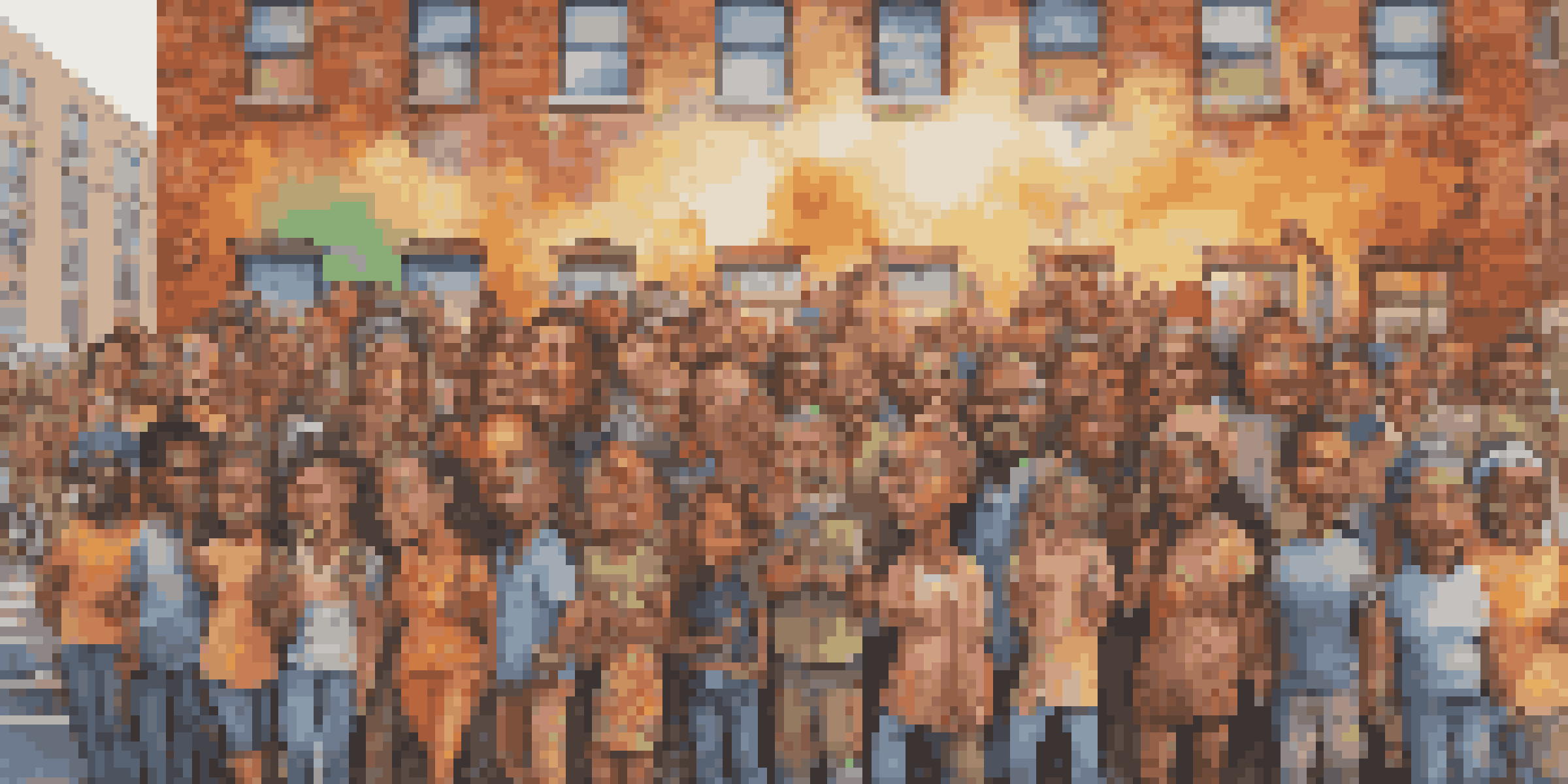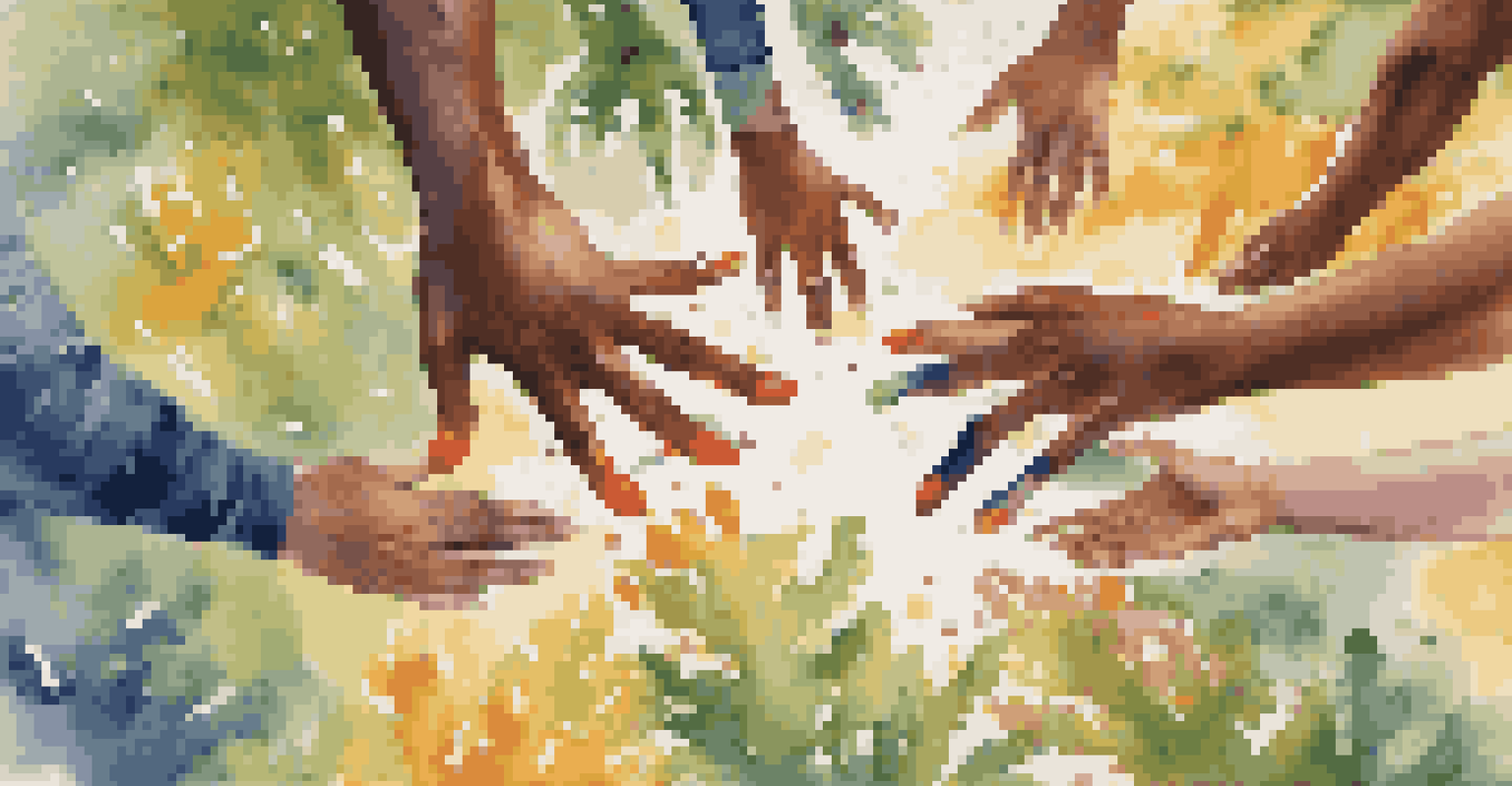Exploring the Role of Art in Human Rights Advocacy

Understanding the Intersection of Art and Human Rights
Art has long been a powerful tool for expression, allowing individuals to communicate their experiences and beliefs. At its core, human rights advocacy seeks to amplify voices, and art provides a unique platform for this. Whether through visual art, music, or performance, creative expressions often capture the struggles and aspirations of marginalized groups.
Art is not what you see, but what you make others see.
For example, street murals can transform public spaces into powerful statements against injustice, serving both as a reminder and a rallying cry. These artistic forms not only raise awareness but also foster empathy, inviting audiences to connect emotionally with issues they may not have encountered otherwise. Thus, art becomes a bridge between cultures, encouraging dialogue and understanding.
Furthermore, the emotional resonance of art can inspire action, driving individuals to engage in advocacy or support movements. By encapsulating complex human experiences in an accessible format, art can motivate people from all walks of life to join the fight for equality and justice.
Art as a Medium for Storytelling in Advocacy
Storytelling through art is a powerful way to share human rights narratives that might otherwise go unheard. Artists often draw on personal experiences or historical events to create works that resonate deeply with audiences. This storytelling aspect connects viewers to the lived realities of others, fostering a sense of shared humanity.

For instance, documentaries and photographic exhibitions can portray the struggles of communities facing oppression, allowing viewers to witness these realities firsthand. Such art not only informs but also evokes emotions that compel people to reflect on their own beliefs and actions. This emotional engagement is key in human rights advocacy, as it encourages a deeper understanding of the issues at hand.
Art Amplifies Human Rights Voices
Art serves as a powerful medium for expression, connecting audiences to the struggles and aspirations of marginalized groups.
Moreover, art can serve as a catalyst for conversation, prompting discussions about difficult topics. When art is used to tell stories of injustice, it creates a space where individuals can explore their feelings and opinions, making it easier to address the complexities of human rights issues.
The Role of Artists in Social Movements
Artists often find themselves at the forefront of social movements, using their talents to advocate for change. By integrating their art into campaigns, they can draw attention to critical human rights issues, mobilizing communities and influencing public opinion. The synergy between art and activism is evident in various movements, where creative expressions have sparked significant dialogue.
The greatest weapon against an oppressor is the mind of the oppressed.
Take, for example, the 'Art for Amnesty' initiative, which showcases works that highlight human rights abuses. Artists participating in such projects not only raise awareness but also generate funds that support advocacy efforts. This collaboration between the arts and activism showcases the power of creativity in driving social change.
Furthermore, artists can inspire others to take action, motivating them to become advocates themselves. By modeling engagement through their work, they create a ripple effect, encouraging their audiences to stand up for justice and human rights in their own communities.
Art as a Tool for Healing and Empowerment
In addition to advocacy, art plays a crucial role in healing and empowering individuals affected by human rights violations. Creative expression can be a therapeutic outlet for those who have experienced trauma, allowing them to process their emotions and experiences. This healing aspect is vital in rebuilding lives and communities that have faced adversity.
Participatory art projects, where communities come together to create, can empower individuals by giving them a voice. These projects often foster a sense of belonging and solidarity, reminding participants that they are not alone in their struggles. By engaging in artistic activities, individuals can reclaim their narratives and assert their identities.
Storytelling Fuels Advocacy Efforts
Through storytelling, artists can share impactful human rights narratives, fostering empathy and prompting discussions on complex issues.
Moreover, art can inspire resilience, encouraging individuals to envision a better future. Through creativity, people can find hope and strength, reinforcing their commitment to advocate for their rights and the rights of others.
Digital Art and Its Impact on Global Advocacy
With the rise of technology, digital art has emerged as an influential medium for human rights advocacy. Social media platforms allow artists to reach global audiences instantly, amplifying their messages far beyond traditional boundaries. This democratization of art empowers individuals to share their stories and advocate for change in real-time.
For instance, hashtags like #BlackLivesMatter have become rallying cries, accompanied by powerful visual art that encapsulates the movement's essence. Digital art serves as a quick and impactful way to raise awareness, mobilize support, and foster community around critical issues. Its accessibility means that anyone with internet access can participate and contribute to the conversation.
Additionally, digital art can transcend geographical barriers, connecting activists and artists worldwide. This global network fosters collaboration and solidarity, allowing diverse voices to unite in their fight for human rights, making movements more resilient and multifaceted.
The Challenges Artists Face in Advocacy
While art can be a powerful tool for advocacy, artists often face significant challenges in their efforts. Censorship, government repression, and societal pushback can stifle creative expression, making it difficult for artists to convey their messages. Such obstacles can discourage artists from addressing critical human rights issues, limiting the impact of their work.
Moreover, funding can be a hurdle, as many artists rely on grants or donations to support their advocacy projects. When resources are scarce, it can be challenging to produce meaningful work that addresses pressing issues. This financial strain can also lead to self-censorship, as artists may shy away from controversial topics to ensure continued support.
Digital Art Transforms Global Activism
The rise of digital art has enabled artists to reach global audiences, democratizing advocacy and fostering collaboration across borders.
Despite these challenges, many artists continue to persevere, recognizing the importance of their role in human rights advocacy. Their resilience highlights the intrinsic value of art in challenging oppressive systems and promoting social change, reminding us that even in adversity, creativity can flourish.
The Future of Art in Human Rights Advocacy
As we look to the future, the role of art in human rights advocacy will likely continue to evolve. New technologies and platforms will provide artists with innovative ways to engage with audiences and spread their messages. Virtual reality experiences, for instance, can immerse viewers in human rights narratives, fostering a deeper understanding of the issues at play.
Moreover, collaboration between artists and activists will become increasingly vital in addressing global challenges. By working together, they can create compelling narratives that resonate with diverse audiences, bridging gaps and encouraging collective action. This partnership can amplify the voices of those often overlooked in traditional advocacy.

Ultimately, the future of art in human rights advocacy lies in its ability to inspire change and promote social justice. As artists continue to push boundaries and explore new mediums, they will undoubtedly play an essential role in shaping a more equitable world, reminding us all of the power of creativity in the fight for human rights.